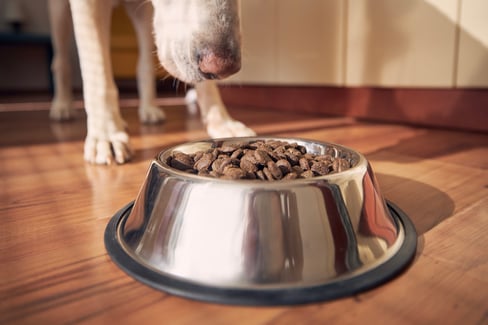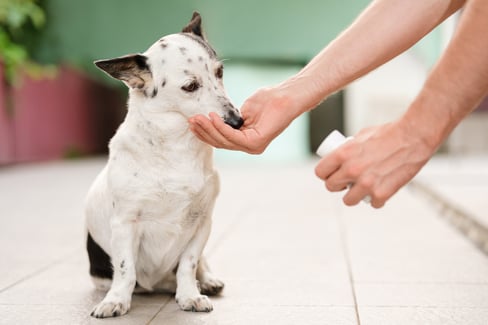Table of Contents
While they might still seem young to us, at around 7-12 years of age, dogs start showing signs of aging. You know what we’re talking about—greying fur, aching bones, and a little less energy than when Fido was a young whippersnapper.
One big part of supporting your aging pooch as he becomes an old dog is to know when to switch to senior dog food and ditch the regular food. Senior dog food has additional nutrients, such as glucosamine for dogs, in it that can help ensure your dog has strong and healthy bones and joints as he ages.
But how do you know when it’s time to switch to senior dog food? This guide goes over that and also talks about the most common myths about senior dog food and the factors you must consider when choosing one.
Common Misconceptions About Senior Dog Food
If you’ve hopped on Google to try to figure out a thing or two about the best senior dog food, you’ve probably come across quite a few different opinions. The trouble is, not all of these opinions are true.
Before knowing when to switch to senior dog food, it’s important to understand a couple of common misconceptions. That way, you can make the right choice for your pup.
Let’s check out a few of these misconceptions below.
All Dogs Need to Switch to Senior Food at 7 Years Old
Most people are aware that the majority of dogs are considered seniors at 7 years old. However, this actually depends quite a bit on the size and breed of your dog. For instance, as a general rule of thumb:
- Small dogs (Chiuauas, Bichon Frises, Yorkshire Terriers) are considered senior at 9-10 years old
- Medium dogs (Australian Cattle Dog, Basset Hound, Bulldog) are considered senior at around 7-8 years old
- Large dogs (Bullmastiff, German Shepherd, Great Dane) are considered senior at around 5-6 years old
But don’t let that fool you into thinking it’s immediately time to switch to senior dog food once your pup hits a certain age. In fact, some vets suggest that no exact age is required for a dog to switch to a more senior diet.
Instead of sticking to a hard and fast rule of a certain age to switch your dog to senior food, look at your pet’s individual lifestyle. Smaller dogs like chihuahuas or poodles may be able to wait until 11 years old to switch to senior food. On the other hand, if you’ve got a bigger dog, such as a golden retriever, who’s showing signs of slowing down, it might be time to make that switch earlier.
Instead of focusing on age, keep an eye on your dog’s health and communication open with your vet. This can help you make the right decision about when to switch your dog to senior meals.
All Senior Dog Foods Are The Same
Another common misconception is that all senior dog foods are the same. However, senior diets can differ in the number of calories and macronutrients. They also have different nutrient and ingredient profiles.
One example of a difference in macronutrients is the protein content. It ranges from 18% to 30% among various senior dog food, especially on a dryer matter basis. Other nutrient profiles that may vary are phosphorus and sodium levels.
Additionally, some types of senior dog food are more targeted at certain diseases, so their nutrient composition will also vary. This is why it’s always best to read senior dog food and supplement labels. Not only does doing so clue you into these types of differences, but it also makes sure you really are choosing the best food for your pup.
Senior Dogs Need Lower Protein
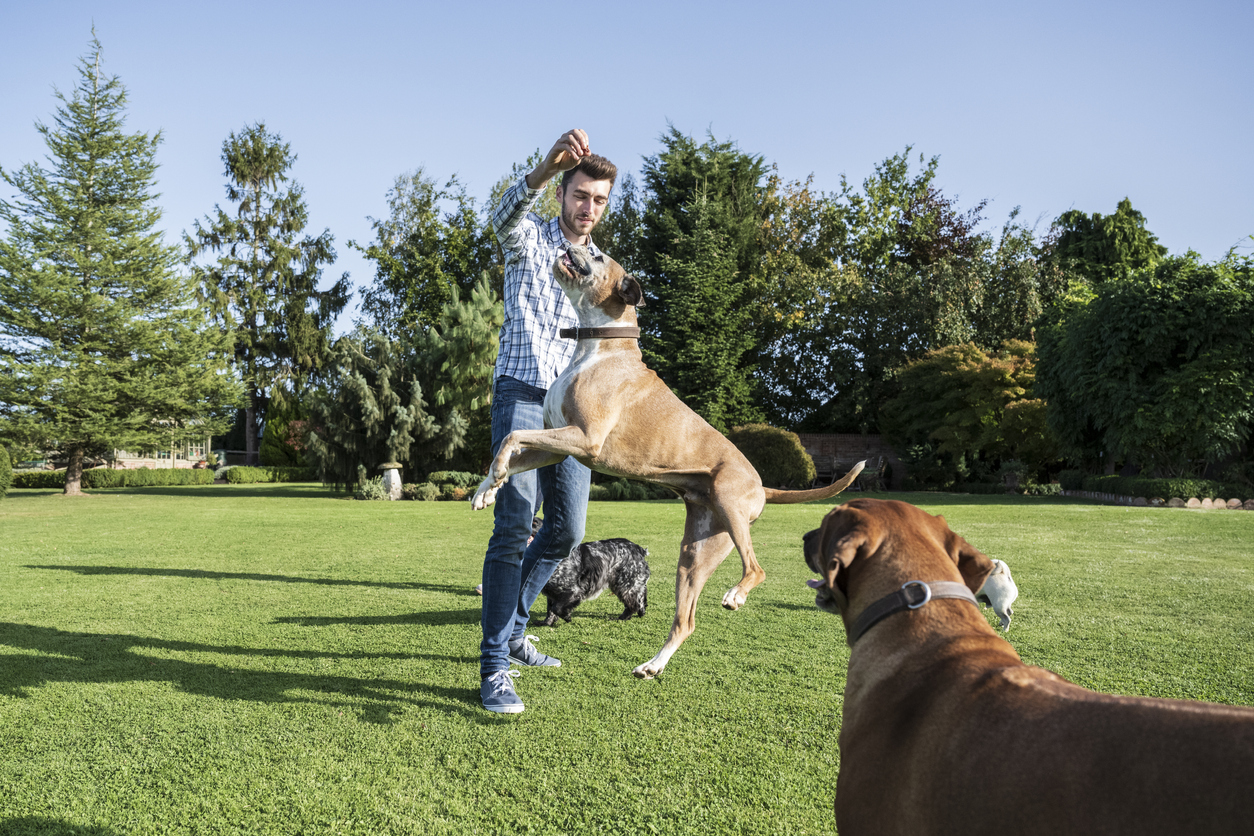
Unlike what Dr. Google might tell you, senior dogs don’t need less protein content. In fact, feeding them a low-protein diet can even be more harmful! This can cause dog muscle loss, which can lead to other major problems.
For instance, muscle loss could cause mobility concerns, whether that’s reduced mobility or pain when your dog tries to romp around as he did when he was younger.
The amount of protein fed to senior dogs varies depending on their breed and whether they have a medical condition. Choosing the best senior dog food involves a conversation with your vet to make sure you’re getting the right amount of protein for your pup’s breed, age, and lifestyle.
Senior Dog Foods are Low in Phosphorus
Most pet owners believe senior dogs should consume lower phosphorus levels because the too much of the nutrient is linked to certain kidney diseases. But this is only a misconception. Phosphorus is one of the important nutrients in keeping a senior dog’s bones healthy and strong.
You should not restrict this, except when your dog has severe kidney disease. It’s also better to consult with your dog’s vet regarding his diet when he has kidney problems. They’ll be able to get your pup set up with food that’s appropriate for him and that won’t further harm his kidneys.
Senior Dog Foods are Low in Sodium
Phosphorous isn’t the only nutrient some pet parents think their senior dog food is lacking. Some pet parents also believe that they’ve got to give older dogs less sodium.
However, this is not always the case. The amount of sodium dogs need varies depending on their breed, and restricting them without consulting your vet can do more harm than good.
Regardless of the breed, dogs normally require at least 0.3% sodium in their diet. You should only need to lower the sodium level of the food senior dogs eat when they have problems with their kidneys, heart, or liver.
Older Dogs Need More Fiber
Optimal fiber content in dog food depends on the dog’s breed, size, and health condition. Feeding them fiber-rich food is inappropriate when your dog is gaining more weight than normal. On the other hand, when you restrict fiber in underweight dogs, this can make them lose more weight.
Although some older dogs may need more fiber, that’s not the case for every pup. Be sure to speak to your vet before making any choices about adding fiber to your dog’s diet.
Not All Seniors Need Supplements
As the name suggests, supplements are adjuncts to make your pets live healthier lives. Now, it is important to note that when senior dogs are eating the proper diet, supplements for old dogs are not technically required. However, that’s not to say that they can’t help tremendously!
A mobility and joint support supplement, like TRI-ACTA, is one good supplement to incorporate into a healthy senior’s diet. TRI-ACTA or TRI-ACTA H.A are unique supplements because they don’t contain any unnecessary fillers or other ingredients that could cause harm to your pooch. All the ingredients in these supplements are naturally occurring in your dog’s joint matrix, but after a certain age, a dog’s ability to create those ingredients starts to decline. This can occur as early as 4 or 5 years old!
The good news is that TRI-ACTA can help prevent or delay the early stages of osteoporosis and keep your senior pooch feeling his best!
TRI-ACTA H.A. for Pets
Our maximum strength formula is optimally designed to accelerate the formation of cartilage, minimize inflammation, expedite the healing process, and improve joint conditions.
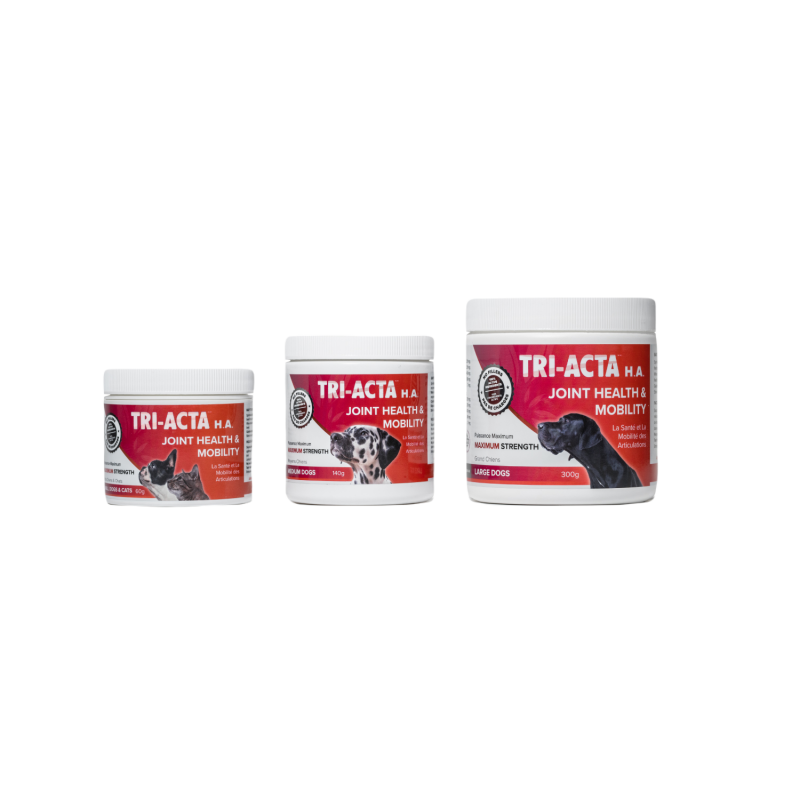
When to Switch to Senior Dog Food
Now that we’ve got the myths out of the way, let’s talk about when you should switch to senior dog food.
At some point or another, changing to senior dog food is inevitable. However, there are a few ways to know when to switch to senior dog food in order to avoid adverse effects on their health and behavior.
Let’s go over a few signs that it might just be time to switch to senior dog food.
If Your Dog is 8 Years or Older
Depending on the dog’s breed, it’s time to switch to senior dog food when he turns eight or older. You should also consider life-stage classifications, as some dogs become seniors between 6 to 8 years old.
The table below can help you determine the life-stage classification of your dog depending on his size and weight. That way, you can make the right choice about switching to senior food for your particular pup!
|
Dog Size |
Puppy |
Adult |
Senior |
Geriatric |
|
Small (<20 pounds) |
Up to 8 months |
8 months to 10 to 12 years |
10 to 12 years until 15 to 16 years |
More than 16 years |
|
Medium (21 to 50 pounds) |
Until one year |
1 to 8 years |
8 to 13 years |
More than 13 years |
|
Large (51 to 100 pounds) |
Until 15 months |
15 months to 7 years |
7 years to 12 years |
More than 12 years |
|
Giant (more than 100 pounds) |
Until 24 months |
24 months to 6 years |
6 years to 9 years |
More than 9 years |
If Your Dog Develops Health Conditions Associated with Old Age
It’s no surprise that dogs can develop certain medical conditions when they age. This is because the body's systems naturally start to deteriorate and weaken.
When you notice that the activity level of your canines is slowing down, it could be a sign their metabolic processes are starting to decrease. During this time, it’s best to consult your vet about whether switching to a senior dog diet is the right thing to do.
When dogs age, their brains can also start to metabolize less glucose, leading to memory problems. If you notice your dog can’t seem to remember learned commands or is showing other signs of memory loss, it may be time to switch to senior food.
Additionally, skin issues can develop when your dog ages. This is a great time to give them food rich in high-fat content, including Omega 6 and Omega 3 fats. Other health issues that may arise include:
- Dental issues – might need to switch to a softer diet or food with rich moisture
- Kidney issues – switch to food with lower protein content
Look for signs of these types of issues to make the right choice about when to move to using senior canine chow.
Your Older Dog Starts to Gain Weight or Lose Weight
Sudden weight gain or loss is a sign that you may need to switch to senior dog food. Still, remember that a dog getting heavier should be given a different type of diet from a dog who is losing weight.
Knowing the body condition score of your dog helps determine whether he is experiencing weight loss or weight gain. The body condition score can also help vets and pet owners determine whether switching the canine’s diet and nutrition are ideal. Everything should be good if your dog maintains a score of 4 or 5.
Weight is also a critical factor in assessing a canine for possible complicated medical conditions that you must address.
Regardless of whether your dog is gaining or losing weight, before making any decisions, a vet consultation is always the first thing to do. This will help you determine the right type of chow for your pooch.
If Your Dog has Difficulty Sleeping or is Sleeping More
Your dog experiencing difficulty in sleeping can be a sign of brain or cognitive issues. This is also when consulting your vet can help determine whether the animal is at risk of more complicated health problems.
Like humans, senior dogs can also experience cognitive dysfunction. This resembles dementia in human beings. Aside from difficulty sleeping, other symptoms include the following:
- Progressive confusion
- Poor adaptability and adjustment to new situations
- Reversal of sleeping and waking patterns
On the other hand, a senior dog sleeping more is likely just a sign that he has reduced activity levels. Vets often suggest this is normal. However, you must give them a diet with additional supplements to ensure they still get the nutrients they need to keep their muscles and bones strong and healthy.
The bottom line is if you sense changes in your dog’s sleeping patterns, consulting the vet is our best advice.
If Your Dog Experiences Gastrointestinal Diseases
Some of the most common GI disturbances in senior dogs include rumbly stomachs, chronic flatulence, and loose stool. These conditions are possible symptoms that the old canine can no longer tolerate the food quality you’re feeding him.
A dog with GI disturbances makes him feel uncomfortable, which can cause him to eat less. Eating less can then lead to your canine losing weight and the nutrients he needs to stay healthy.
There are several approaches to minimizing GI upset in senior dogs:
- Feeding them smaller portions several times a day rather than once or twice
- Adding GI supplements to your dog’s diet (following the advice of a vet)
- Changing to food that is more easily digestible (which can include senior dog food)
Giving your senior dog small amounts (a tablespoon or two) of plain, flavorless and sugar-free yogurt can help, as the yogurt has probiotics that can help their digestion, at least in the short-term. In addition, having a fresh supply of water available to your dog at all times is extremely important, as intake of water helps digestion.
Of course, it’s always important to consult your vet if you have ongoing concerns about your dog’s tummy troubles.
If Your Dog’s Current Diet Doesn’t Have Enough Fatty Acid
Senior dogs are more prone to developing flaky fur or coat. To prevent this from worsening, you need to provide them with a diet rich in fatty acids like Omega-6 and Omega-3. These nutrients are essential to keep your pet’s skin healthy, preventing flakiness and dullness.
If your senior dog isn’t getting enough fatty acid from his regular dog chow, it could be a sign that it’s time to switch to senior food. Keep an eye on your dog’s fur condition and let your vet know if you notice any changes that could signify not enough fatty acid.
Your Dog is Experiencing Itchiness
Allergies are common in old dogs, causing them to itch more than normal. Itchiness can also signify that your pet is allergic to what he’s eating. After consulting with your vet, switching to a low-allergen diet or a diet with a novel protein can help prevent severe itching, which reduces the chance of your senior dog experiencing discomfort.
A low-allergen diet reduces the risk of your dog's exposure to allergens that can cause itchiness. This type of diet is commonly prescribed by a vet, depending on the specific needs of the old dog.
How to Choose a Senior Dog Food
Transitioning to senior dog food is not an easy task. For one thing, choosing the best senior dog food also means you need to consult with the veterinarian. The vet will help you make the right choice for senior dog food for your particular pet.
However, a few other tips you can keep in mind for choosing the most suitable senior dog food for your canine include:
- Look for the senior version of their current brand
- Vet recommendations
- Reviews
- Finding specific food for your dog’s breed or size
- Consider key ingredients
Let’s dive deeper into each of these factors.
Look For the Senior Version of Their Current or Similar Brand
Once the vet gives you the go-ahead to switch to senior dog food, it’s always best to start with the senior version of your dog’s current food or diet. These can be in the same brand, texture, or variety. This is possible because it’s common for most brands to offer senior versions of adult foods.
The good thing about this is that GI disturbances or food intolerances will be less risky since your canine is already used to eating food from the same brand. Doing this also prevents your dog’s digestive system from undergoing discomfort because of the diet change.
Another option is to look for a different brand with the same nutrient profiles and ingredients. Let’s say your canine is used to eating rice, kibble, and chicken. It’s best to look for senior dog food containing the same ingredients to help avoid upset tummies or allergic reactions.
Vet Recommendations
Another thing to keep in mind is what your vet recommends. Vet recommendations are best for senior dogs with medical conditions. Sick dogs are more prone to developing infections and allergies, so their diet should be particular with the right nutrients, vitamins, and minerals.
Vet recommendations are also best when your dog needs a prescription or a therapeutic diet. These diets normally have additional formulation-specific ingredients to aid your dogs’ health and keep them in tip-top shape.
Reviews
Like any product, reviews should be taken into account when it comes to choosing the right senior dog food. These are testimonials that help you decide whether a particular senior dog food is beneficial for your pet. These reviews can prove whether trusting certain dog food brands can bring more good than harm.
Reviews can come in different kinds, like word-of-mouth and online testaments.
Finding Specific Food for Your Dog’s Breed or Size
Even though senior dog food varies, you can still see brands offering particular food types depending on the dog’s breed and size. The dogs’ body systems differ according to their size, so consider this when switching to senior dog food.
Additionally, senior dog food varieties are normally formulated with size or breed-specific ingredients. These factors can include the following:
- Size
- Texture
- Kibble shape
- Additional ingredients for certain diseases
Consider Key Ingredients
Aside from the usual macronutrients like protein and carbohydrates, you should also consider other vital ingredients that are helpful for your dog’s health. We’ve curated some of the most important key ingredients to check when looking for an ideal senior dog food:
- Chondroitin and Glucosamine – for your dog’s cartilage and joints
- Antioxidants – for the immune system’s defense
- Consider Lower Sodium and Phosphorus levels – to maintain optimal kidney function
- Omega-3 fatty acids – to keep the dog’s fur and skin healthy
- Fibers – combat constipation
For a therapeutic dose of chondroitin and glucosamine for mobility support, use a supplement like TRI-ACTA H.A.
TRI-ACTA H.A. for Pets
Our maximum strength formula is optimally designed to accelerate the formation of cartilage, minimize inflammation, expedite the healing process, and improve joint conditions.

Top 3 Brands to Consider When You Switch Your Dog to Senior Dog Food
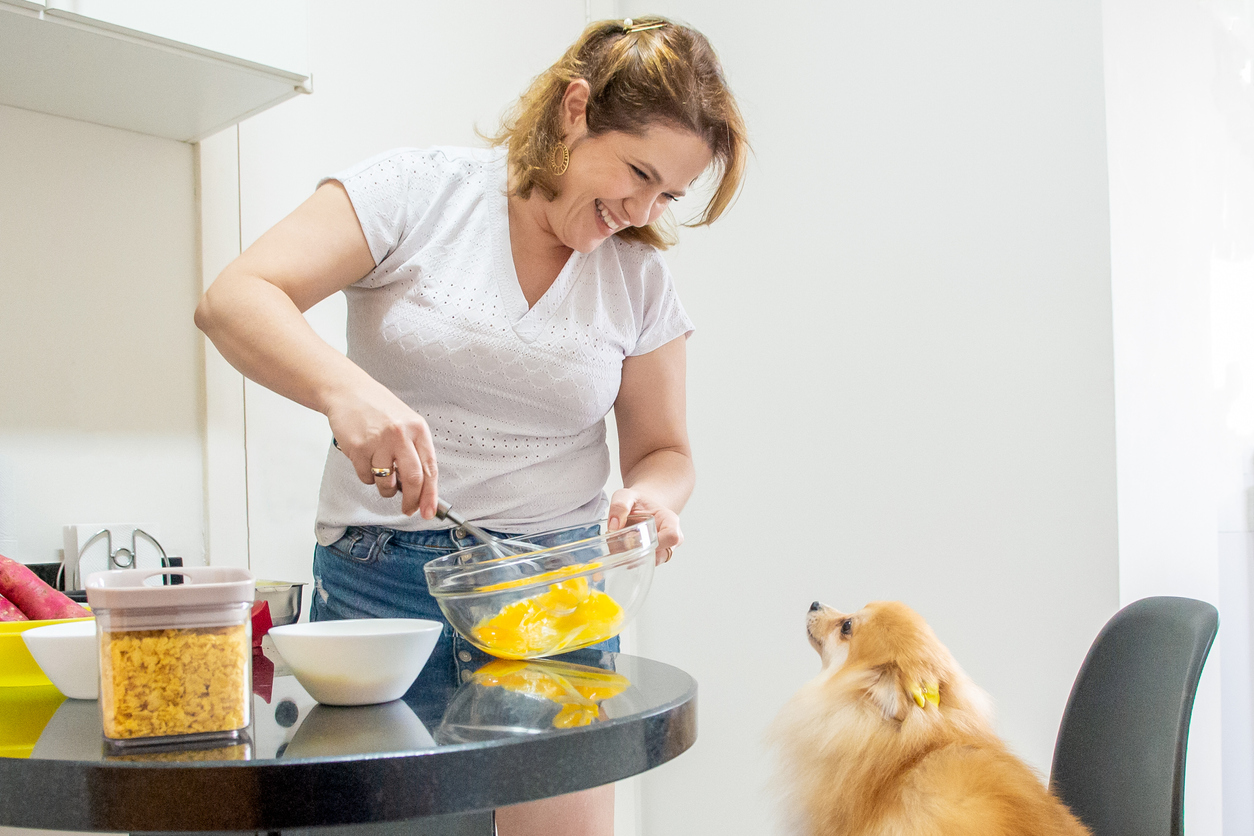
There are several different dog food brands on the market today, which can make it tough to know which senior chow to switch too.
However, a few of the three top brands are outlined in the table below. Any of these three brands could be a good pick for helping your pooch transition to senior food.
|
Dog Food Brand |
Ingredients |
Type |
|
Ollie Chicken and Carrots |
Chicken liver, carrots, peas, rice, chicken liver |
With grains |
|
The Farmer’s Dog |
Carrots, broccoli, chickpeas, spinach, turkey |
Grain-free |
|
Wellness Core |
Chicken meal, lentil, deboned turkey, peas, |
Grain-free |
Ollie Chicken and Carrots
Ollie Chicken and Carrots senior dog food is a veterinarian-prescribed meal. This means that the meal plan created is based on a canine’s weight, age, activity level, and breed size. What’s great about this option is that all ingredients are natural and 100% human-grade.
Ollie Chicken and Carrots sources its meat protein from freshly slaughtered chicken. With the dry matter level analysis, you can guarantee this brand contains the following nutrient profile:
- 30% fat to protein ratio
- 11% fat
- 37% protein
- 44% estimated carbohydrates
Another benefit of Ollie Chicken and Carrots is that it suitable even to dogs with picky or sensitive stomachs. The reason behind this is that the ingredients are fresh and safe. A downside of this brand is that it’s on the expensive side, so we don’t recommend this when you want a meal plan on a budget.
The Farmer’s Dog
The Farmer’s Dog senior dog food presents homemade meals with the right balance of natural ingredients. A board-certified veterinary nutritionist designed this brand's diet plans, so you can guarantee its safety and healthiness.
The Farmer’s Dog is also human-grade, with fresh turkey as its main meat protein source. The following are its macronutrient composition:
- 56% fat to protein ratio
- 19% fat
- 33% protein
- 40% estimated carbohydrates
What’s also great about this brand is its conduction of live feeding trials done on multiple dog breed sizes at the age of 6 and above. The Farmer’s Dog also guarantees all meal plans are made in USDA kitchens.
Wellness Core Senior Dog Food
A standout feature of Wellness Core Senior Dog Food is that it’s low-calorie. This brand is known for creating balanced meal plans, making them suitable for almost all types of senior dog breeds and sizes. Ingredients are freshly harvested every day, and this brand caters to people on a budget because of its affordable price range.
The main protein source of Wellness Core includes chicken meals and fresh turkey. The following are included in its macronutrient composition:
- 38% fat to protein ratio
- 36% protein
- 43% estimated carbohydrates
- 13% fats
Aside from the macronutrients, Wellness Core also contains chondroitin and glucosamine for optimal joint health and omega-rich salmon oil. It also has the right calories for obese senior dogs who need to control their weight.
Supplementing Senior Dog Food
Senior dogs with reduced activity levels may need additional supplements to add to their diet’s nutrient profiles. This can help keep them healthy, happy, moving, and living their best life.
One helpful supplement for senior dogs is TRI-ACTA H.A. This supplement is helpful in preventing and treating mobility issues and concerns, even when he is not as active as he was when he was younger. TRI-ACTA H.A. contains the right nutrients to prevent muscle and joint weakness.
TRI-ACTA H.A. for Pets
Our maximum strength formula is optimally designed to accelerate the formation of cartilage, minimize inflammation, expedite the healing process, and improve joint conditions.

Summary
Although most of us would like to think our dogs will live forever, eventually, even Fido will start to show signs of graying fur and aging bones. Looking for these signs can help you know when to support your pup’s transition to the senior canine community through dog food for seniors.
Once you’re sure it’s time to switch to senior dog food, remember to check for key ingredients and reviews to make sure you’re getting the right nutrients for your aging pup.
Besides switching to senior dog food, supplementing your pup’s diet with a product like TRI-ACTA H.A. also helps. This supplement ensures optimal joint and muscle health to keep your canine strong even as he heads into his golden years. Check out our FAQ page, or get in touch with us to learn more about how these supplements can support your dog’s aging!
Newsletter Signup
Subscribe to our newsletter to receive the latest news and exclusive offers.
.jpg?height=2000&name=Cliick_Integricare-DISPLAY-REVISEDV2%20(1).jpg)
Proactive & Therapeutic Joint Supplements
When given daily, Integricare joint supplements recover bone and joint injuries faster and help prevent mobility injuries from happening in the first place.







